 |
 |
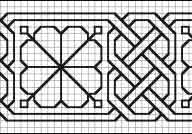 |
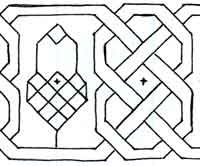 |
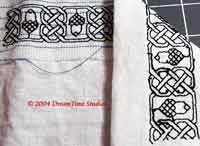 |
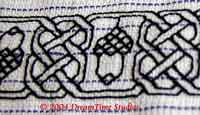 |
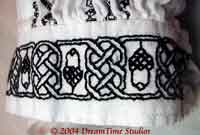 |
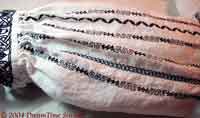 |
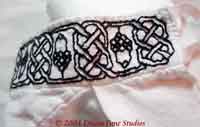 |
This is my husband's 1580's blackwork shirt that I started on December 8, 2003. It was completed sometime in early March 2004. A sideview of my husband wearing the shirt underneath his doublet can be seen at right. The shirt design is one based solely on rectangles (the historical way to conserve expensive materials), with blackwork embroidery, hand worked on the collar and cuffs, and faked (modern) machine embroidery on the sleeves.
The Shirt Design:
The fabric is 100% linen, light in weight, but heavier than a handkerchief weight. The linen was washed multiple times in hot water to shrink it as much as possible. This also softens the linen. While a bit of work to start, linen is worth every effort for a shirt which is much cooler and definitely more historically appropriate than a shirt made of cotton. Linen wicks away the sweat from the body, making it feel cooler. Linen also dries quicker than cotton.
The basic shirt pattern is from Janet Arnold's original detailed information that I found on the Internet1; The image is good enough to make out most of the notations written with the pattern, along with the scale for enlarging.
The body, sleeves and underarm gussets are machine sewn and finished. The collar gussets are sewn and finished by hand. By finish, I mean the seams are sewn to prevent unravelling of the fabric.
Blackwork Embroidery:
There are several excellent Internet sites available that discusses blackwork in detail. Historical blackwork designs used to be found at Bronwen's Blackwork Library2, but that information is no longer available online. I chose to blend two images, one from an English sampler, and the other from an German sampler. The final chart blended the two nicely, I think. More than that, it had meaning for my husband, who likes oaks.
The embroidery is a double running stitch, otherwise known as an Holbein stitch, and produces the same design on both front and back of the fabric. This design was hand sewn on the collar and cuffs, and worked over waste cloth attached to the linen, as this linen was very uneven between warp and weft. The embroidery on the sleeves are various machine stitches done to create a semblance of blackwork from a distance, appropriate for our local Renaissance faires.
If I was to do this as commission, I would suggest getting an even-weave linen of matching color to the main fabric to do the blackwork embroidery directly. Removing the waste cloth upset the original stitching, producing an uneveness to the stitches.
Conclusion:
A fine linen shirt, especially set off with blackwork embroidery, is an excellent base for any historical garment. While linen is now more expensive than cotton, it more than makes up for the cost in comfort and extended wear. My husband's linen shirt has already seen many washings, with minimal wear. He declares it is a very comfortable shirt, even compared to his normal cotton tees, and the linen gets softer over time.
Internet Resources:
- Cut, Construction, and Ornamentation of Elizabethan Shirts, http://home.earthlink.net/%7Emagdlena/shirt/shirt.html. Magdalena da Cadamosto aka Christina Biles. Also see the extensive bibliography at the bottom of the page.
- Bronwen's Blackwork Library, http://costume.dm.net/blackwork/index.html. Claudette Ziemann. Historical designs are no longer available online, but I have heard she may create a book of designs.
Further information from my own library:
- Arnold, Janet. (1985). Patterns of Fashion : the Cut and Construction of Clothes for Men and Women c1560-1620. London : Macmillan. ISBN 0896760839
- Ashelford, Jane. (1996). The Art of Dress : Clothes and Society, 1500-1914. London : National Trust ; New York : Distributed by Abrams. ISBN 0810963175
- Cunnington, C. W., & Cunnington, P. (1981). The History of Underclothes. New rev. ed. London ; Boston : Faber and Faber. ISBN 0486271242
- Hart, Avril & North, Susan. (1998). Fashion in Detail : from the 17th and 18th Centuries. New York : Rizzoli. ISBN 084782151X
- Hunnisett, Jean. (1991). Period Costume for Stage & Screen. Patterns for women's dress, 1500-1800. Studio City, CA : Players Press. ISBN 0887346103
Home
Kimiko Small Designs
Joan Silvertoppe's SCA Resumé
Warderobe Accounts
Brodyworke Accounts
Scriptor Arts Folium
Tudor Research
Workshops & Articles
Inspiration Gallery
Largesse
Favorite Links
About Me
Contact Me
http://www.kimiko1.com
Entire website, graphics, and text (unless otherwise stated)
© 2003-2013 Kimiko Small, All Rights Reserved


